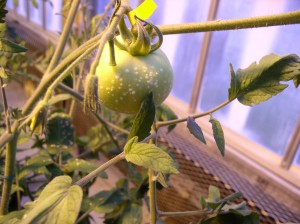Xanthomonas campestris pv. campestris (Xcc)
Genetic fingerprinting of Xanthomonas campestris pv. campestris
We have an ongoing collection of isolates of Xanthomonas campestris pv. campestris, the bacterium responsible for black rot disease of crucifers. Understanding the epidemiology and diversity of the pathogen in New York State will guide management recommendations for this perennially problematic disease. We have been using a DNA fingerprinting technique to compare isolates across the state and between years. Now, in addition to the fingerprinting, we use multi-locus sequence analysis to compare the isolates to each other and the global population. We also collect cruciferous weeds to see if they serve as a reservoir for the pathogen, and use MLST (multilocus sequence typing) to analyze pathogen isolates from weeds.
Field studies
Each year we do a field study funded by the cabbage research and development program to try to solve issues that impact New York state cabbage growers. This includes collecting the Xcc isolates which cause disease each year, studying the impact of weeds on the pathogen’s ability to overwinter, greenhouse studies on black rot in crucifers used as cover crops, and evaluating different copper compounds. Our latest trial was to evaluate 34 of the cabbage varieties currently grown in New York for their susceptibility to black rot. In greenhouse transplants, we compared copper and Actigard (salicylic acid analog) and are also comparing treating different age groups of transplants for reducing Xcc populations.
Clavibacter michiganensis subsp. michiganensis (Cmm)
Understanding vascular colonization of tomato by Clavibacter michiganensis subsp. michiganensis
Understanding the biology of a pathogen is crucial to developing resistant plant varieties. We are decoding the pathogenic factors of the Gram-positive bacterium, Clavibacter michiganensis subsp. michiganensis (Cmm), the causal agent of bacterial wilt and canker in tomato. Cmm is the most devastating bacterial pathogen in the tomato industry, and continues to spread globally due to insufficient seed screening methods. Currently, there are no resistant tomato cultivars and limited chemical controls. Past studies have suggested that the bacterium may be localizing intracellularly without lysis in some tissues, mainly in the vascular tissue. We are working to elucidate how Cmm invades developing seeds, spreads throughout the plant, and which virulence genes permit xylem colonization and systemic infection in tomatoes.



